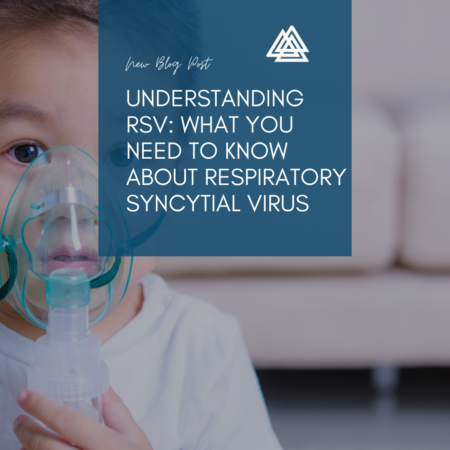 As the colder months approach and respiratory illnesses become more common, it’s crucial to be informed about Respiratory Syncytial Virus (RSV), a prevalent and potentially serious virus that primarily affects young children and older adults. RSV is a major cause of respiratory illness in infants and can lead to severe complications, especially in vulnerable populations.
As the colder months approach and respiratory illnesses become more common, it’s crucial to be informed about Respiratory Syncytial Virus (RSV), a prevalent and potentially serious virus that primarily affects young children and older adults. RSV is a major cause of respiratory illness in infants and can lead to severe complications, especially in vulnerable populations.
In this blog post, we will explore what RSV is, its symptoms, risk factors, and preventive measures to help you stay informed and prepared.
What is RSV?
Respiratory Syncytial Virus (RSV) is a highly contagious virus that infects the respiratory tract. It is a leading cause of bronchiolitis (inflammation of the small airways in the lungs) and pneumonia in children under the age of 1. While RSV infections are common and often mild, they can cause severe respiratory illness in certain individuals, leading to hospitalization and, in rare cases, even death.
RSV spreads through respiratory droplets when an infected person coughs or sneezes. It can also spread by touching surfaces or objects contaminated with the virus and then touching the face.
Symptoms of RSV
RSV symptoms can vary from mild to severe and may include:
- Mild Symptoms: Similar to the common cold, RSV may present with a runny nose, sneezing, cough, mild fever, and a sore throat. Some individuals may also experience decreased appetite and mild irritability.
- Moderate to Severe Symptoms: In more severe cases, RSV can cause significant respiratory distress, including:
- Wheezing (a high-pitched whistling sound when breathing)
- Rapid or shallow breathing
- Difficulty breathing or gasping for air
- Persistent cough
- High fever
- Cyanosis (bluish color around the lips or face)
Infants and young children with severe RSV may show signs of dehydration, such as reduced wet diapers or dry mouth, and may exhibit lethargy or difficulty feeding.
Risk Factors for Severe RSV
While RSV can affect anyone, certain groups are at higher risk for severe illness:
- Infants and Young Children: Especially those under 6 months old or born prematurely (before 37 weeks of gestation). Their immune systems and respiratory systems are still developing, making them more susceptible to severe complications.
- Children with Chronic Health Conditions: Conditions such as congenital heart disease, chronic lung disease, or immunodeficiency can increase the risk of severe RSV.
- Older Adults: Seniors, particularly those with chronic illnesses or weakened immune systems, are also at higher risk of severe RSV.
- Children in Group Settings: Babies and toddlers who attend daycare or have close contact with other children are more likely to contract RSV due to the close proximity and frequent contact.
Preventing RSV
While it may not be possible to completely prevent RSV, there are several steps you can take to reduce the risk of infection:
- Practice Good Hygiene:
- Handwashing: Regularly wash your hands with soap and water for at least 20 seconds, especially before feeding or caring for an infant.
- Avoid Touching the Face: Minimize touching your eyes, nose, and mouth, as this can transfer the virus from contaminated surfaces to your respiratory tract.
- Avoid Close Contact with Sick Individuals:
- Keep infants and young children away from people who are ill, especially those showing symptoms of a respiratory infection.
- Clean and Disinfect Surfaces:
- Frequently clean and disinfect commonly touched surfaces, such as toys, doorknobs, and countertops, to reduce the spread of the virus.
- Limit Exposure During RSV Season:
- RSV is most common during the fall and winter months. During this time, avoid taking infants to crowded places where the virus is more likely to spread.
- Encourage Respiratory Etiquette:
- Teach older children and adults to cover their mouths and noses with a tissue or elbow when coughing or sneezing and to dispose of tissues properly.
- Consider RSV Prophylaxis:
- For high-risk infants, such as those born prematurely or with certain medical conditions, a medication called palivizumab may be prescribed by a healthcare provider to help prevent RSV infection.
When to Seek Medical Attention
If you suspect that your child or a loved one may have RSV, it’s important to monitor their symptoms closely. Seek medical attention if you notice:
- Difficulty breathing or persistent wheezing
- Severe or worsening symptoms, including a high fever
- Signs of dehydration or lethargy
- Cyanosis (bluish color around the lips or face)
In severe cases, RSV can require hospitalization for supportive care, such as oxygen therapy or intravenous fluids.
Staying Informed and Prepared
RSV is a common respiratory virus that can pose significant risks, particularly to young children and older adults. By understanding the symptoms, risk factors, and preventive measures, you can take proactive steps to protect yourself and your loved ones from RSV.
Staying informed and practicing good hygiene are key to reducing the spread of RSV and minimizing its impact. If you have concerns about RSV or your family’s health, consult with your healthcare provider for personalized advice and guidance. By staying vigilant and prepared, you can help ensure a healthier, safer season for everyone.
